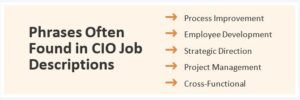You’re a Chief Information Officer (CIO) with proven expertise and an impeccable record of success. You’ve started considering your next career move. Now, you need to introduce your unique strengths and abilities while standing out from the proverbial crowd.
You need a resume.
A stellar resume plays a vital role in highlighting your relevant skills, professional experience, education, and more for recruiters and hiring managers.
Here are 6 steps to help your resume make an impact:
1. Be logical. As a CIO, creative and analytical thinking are innate for you. You’re likely aware that hiring managers utilize automated applicant tracking systems (ATS) to rapidly scan resumes. So, in designing your resume, be pragmatic, organized, and efficient. Set one-inch margins for some white space. Use simple headings and an easy-to-read font like Arial, Book Antiqua, Calibri, Garamond, or Georgia. And leave out flashy graphics and table features.
2. Be upfront. To hire you, potential employers need to know who you are and where to find you. At the top of your resume, in bold 20- to 24-point font, state your name. This header should also include, in smaller font, your phone number, a professional-sounding but personal email (not your current company’s), and your LinkedIn URL. City and state are acceptable, but your street address is unnecessary; you might leave off location altogether if you are seeking a remote position or considering relocating.
3. Be distinct. The title of the position for which you are applying might be CIO or Chief Technology Officer or something else. Tweak this title to match each potential job of interest. Next comes your Unique Success Proposition™. This short 3–5 sentence summary is designed to draw the reader in, fusing how your technical know-how, business acumen, and top achievements have positioned you for advancing an IT division. Quantifiable details and data will always set you apart.
4. Be honest. Potential employers want to know that you not only have experience in infrastructure, systems development, and cloud migration, but also that you have interpersonal and communication abilities that will make you a valuable executive and team player. Creating your Core Competencies or Areas of Expertise section is a phenomenal way to include ATS-pleasing phrases, like “Team Leadership” and “Strategic Relationship Management.”

5. Be proud. Another essential part of your resume is your employment history. Your resume’s job is to sell yourself, so beneath the Professional Experience heading, list each company where you’ve worked, its location, and your tenure in years (for example, 2013–2018). Then describe each role’s responsibilities in a short paragraph followed by bullet points emphasizing specific accomplishments: how a data solution generated $X in revenue or the way a deployed service increased efficiency by Y%. Start each line with an action verb—introduced, architected, delivered, saved. Focus only on jobs held within the past 10 to 15 years.
6. Be inclusive. List your education (all degrees and learning institutions) as well as technology-related certifications. Also note projects, presentations, volunteer engagement, and awards to show the big picture of you.
For more tips or an expert touch, consult our comprehensive Chief Information Officer Resume Guide.


